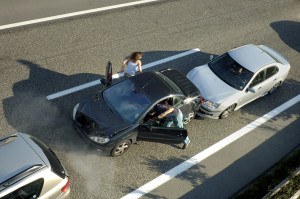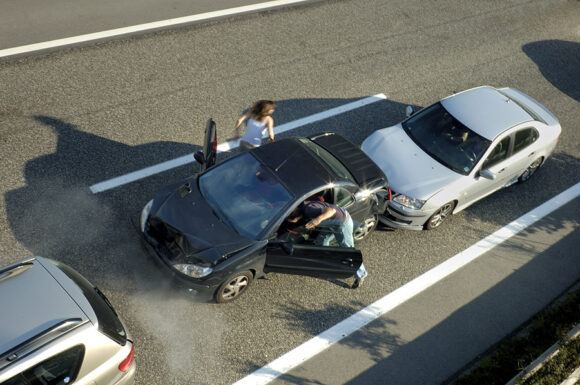There are a few questions in life that are more confusing than their answers. The blanket query into whether or not insurance follows the car or the driver in a particular jurisdiction is such a question – one we see regularly. It isn’t a dumb question. It is more like a MENSA brain teaser than a legitimate insurance question, and it is usually the wrong question to ask.
 The answer to whether insurance follows the car or driver depends on many variables, most notably the kind of insurance coverage being referred to. There are coverages that follow the car and coverages that follow the driver. In general, auto insurance follows the car instead of the driver, but the specifics of a claim can differ since insurance laws and coverage vary depending on the policy, coverage and state being dealt with.
The answer to whether insurance follows the car or driver depends on many variables, most notably the kind of insurance coverage being referred to. There are coverages that follow the car and coverages that follow the driver. In general, auto insurance follows the car instead of the driver, but the specifics of a claim can differ since insurance laws and coverage vary depending on the policy, coverage and state being dealt with.
Liability Coverage
Liability insurance coverage on a personal auto policy follows the driver no matter whose vehicle is being operated, provided it is an eligible vehicle. All states, except for one (New Hampshire), require at least liability coverage. Liability coverage protects the insured (i.e., follows the driver) when the insured operates a vehicle owned by someone else. In such a situation, they will still usually be covered under their own auto insurance policy. However, the best rule of thumb in looking for coverage under a policy is to begin with the exclusions.
While an “insured vehicle” may include a friend’s or neighbor’s vehicle or a rental car, if the vehicle was available for regular use, it might be excluded. A “replacement” vehicle will probably be covered, but in some cases only under circumstances where the insured’s vehicle cannot be operated for some specific reason, such as a repair. Coverage might not follow anyone if the insured is driving a vehicle other than a “private passenger vehicle not owned and listed on the insured’s policy.” There really is no such thing as a standard auto policy anymore and coverage for non-owned autos will be different under some policies and non-existent under others.
Comprehensive and Collision
Comprehensive and collision auto insurance coverage, on the other hand, are tied to the insured vehicle (they follow the car). These coverages pay for damage that befalls the insured vehicle as a result of an accident or vandalism. One could say that if you loan your vehicle, you loan your insurance. With comprehensive insurance which covers almost everything, it is the car rather than the driver that is covered. This, however, requires many stipulations to be put in place, such as who is allowed to drive the car. If someone other than the insured is driving a vehicle covered by comprehensive coverage and is not listed as a covered driver – even if the other person has permission – the other person might not be covered in an accident. Family members (such as children or a spouse) are generally already included in the policy definition of “insured.” However, rarely will insurance cover a driver operating a vehicle without the owner’s permission.
Other Drivers Driving the Insured’s Vehicle
When an insured allows other drivers to drive his vehicle, then, and only then, does the question of whether insurance follows the car or the vehicle become even awkwardly relevant. The right question to be asking is not whether insurance follows the car or the driver, but whether or not other drivers will be covered by the insured’s auto insurance.
Unfortunately, there is no bright line answer to the question, and it depends greatly on the language of the policies involved, the jurisdiction you are concerned with, and the specific facts involved. Permissive use is generally covered under the liability terms of an auto policy. As always, however, there are exceptions.
There are certainly insurance carriers and policies that will not cover any driver not specifically named in the policy. Other relevant facts include where the “other driver” resides and if they are related to the insured. In general, if someone is living in the insured’s household and regularly drives the insured’s vehicle, many insurance carriers expect you to have that person named on the policy. They will need to undergo the same underwriting and qualification process as any other policyholder.
In some cases, if a family member is visiting and has permission from the insured to drive the family vehicle, there will be coverage if there is an accident, but the coverage may be limited. All policies should be reviewed to determine if there are any excluded drivers and any limitations on coverage for anyone driving the car that is not specifically named on the policy.
When the policy of the vehicle owner and the policy of the permissive user have different limits, the matter becomes even more complicated. If the damages caused by the permissive user’s negligence exceed the owner’s liability limits, the policy of the permissive user might be tapped as secondary coverage, but usually only where the permissive user’s liability limits are higher than the owner’s liability limits.
The Insured Driving Someone Else’s Vehicle
In general, insurance coverage for an insured driving someone else’s vehicle is the coverage he carries for his own vehicle. The driver’s personal coverage will apply in most cases when driving a vehicle he does not own. This includes any uninsured motorist coverage he carries and the medical portions of his policy. The driver’s property damage coverage might carry over while driving another’s car as well, depending on the policy language, the respective limits of the two policies involved, and the facts. If a person drives his own vehicle without insurance, he should not expect that he is covered when driving someone else’s vehicle.
Certain factors must be considered in determining if an insured is covered when driving someone else’s vehicle, including the reasons for driving the vehicle, if the insured had permission or not, or if it was a rental or dealership loaner. In each case, the individual circumstances and state law involved will factor into the outcome, but another policy might be considered primary over the insured’s.
When an insured borrows a vehicle from a friend, the insured’s liability coverage usually steps in only when the insured’s policy limits are exceeded. Collision and comprehensive coverage do not apply to a borrowed vehicle. Medical Payments (Med Pay) and Personal Injury Protection (PIP) coverage, as we will see below, also follow the insured into a borrowed vehicle.
Med Pay and Bodily Injury Insurance
Med Pay and bodily injury insurance are two other types of coverage that usually follow the person, not the car. Med Pay coverage pays for any injuries that an insured or his passengers may incur in an accident, regardless of who is at fault. Such coverage usually follows the driver. It is based on people, not the vehicle. In fact, such coverage sometimes covers the insured when he is walking or biking. This coverage also usually follows the driver when he rents a car, because the rental vehicle is a substitute for the insured’s own vehicle. However, Med Pay coverage sometimes follows the car. If the passengers in a vehicle don’t have coverage of their own, Med Pay and PIP coverage can extend to their injuries.
Drivers from Other States
Auto insurance will generally cover a driver from any state as long as he has the insured’s permission to operate the vehicle. However, this isn’t always the case. In all instances, when someone else operates the insured’s vehicle, the auto coverage and policy terms may vary greatly depending on the carrier and insurance options selected by the insured. That said, if an insured is driving a company/commercial vehicle which has Med Pay/PIP coverage, that coverage is usually primary over the driver’s personal auto policy, which will be secondary in terms of coverage. There are some exceptions.
Insurance Coverage When the Insured Is Not Present
In order for insurance to cover an accident when the insured is not present, there will need to be comprehensive auto coverage. The facts of each such case definitely matter. If the driver is a relative, then most likely the absent insured’s insurance will cover the accident. The driver also needs to have had permission, express or implied, or the insured’s insurance may not cover the claim, unless the vehicle was stolen. Individual insurance companies and policies may vary in regard to these rules.
Sub-Standard Policies
Cheap, sub-standard auto carriers write insurance for insureds with bad driving records. They are able to do this by setting their own limited conditions under which they will provide coverage. These sub-standard carriers do not cover claims that would be covered under a more standard policy. These policies can contain “named-driver exclusions” which limit coverage to persons specifically named in the policy. “Step-down” policies often lower liability coverage to a state’s minimum limits for permissive users, even if the insured pays for higher limits. Deductibles can be higher and/or a policy won’t extend coverage to a rental vehicle. Therefore, policy terms vary and directly affect whether a particular coverage follows the car or the driver.
So Does Insurance Follow the Car or the Driver?
As we have seen, this is usually not the right question to ask. However, that won’t prevent inquiring minds from asking – over and over. An answer to the question that isn’t going to be universally correct, therefore, is that insurance that follows the car usually has the vehicle listed in the policy. If anyone who has your permission drives the car, that person is probably covered by virtue of the fact that the car is covered. However, as we’ve seen, this kind of insurance does not cover everyone. There are qualifications for the drivers covered. Other types of coverage such as collision or comprehensive insurance will usually follow the car. These coverages will usually not “follow the driver” to any vehicle which the “covered” driver operates.
Insurance that follows the driver will usually be limited to some form of liability coverage.
When an insured drives someone else’s vehicle, such as a rental car, a dealership loaner, or a friend’s car, he is usually covered for liability insurance. However, other policies which may be deemed “primary” over the insured’s personal auto policy may also come into play.
Therefore, a very basic and often incorrect answer to the wrong question is that auto liability coverage generally follows the driver, while auto physical damage coverage generally follows the vehicle. However, more often than not, you will be asking the wrong question. As long as a driver has the vehicle owner’s permission to operate the vehicle, the owner’s policy will provide coverage no matter who the driver is. The vehicle owner’s policy should cover injuries and property damage. However, exceptions do exist. In most cases, therefore, the right question to ask would be “Is there insurance coverage under these specific facts?”
Was this article valuable?
Here are more articles you may enjoy.



 Tesla Drivers Are Buying Escape Tools and Cars to Avoid Getting Trapped Inside
Tesla Drivers Are Buying Escape Tools and Cars to Avoid Getting Trapped Inside  Poorer Americans Dropped Federal Flood Insurance When Rates Rose
Poorer Americans Dropped Federal Flood Insurance When Rates Rose  Jump Trading Faces $4 Billion Terraform Administrator Suit
Jump Trading Faces $4 Billion Terraform Administrator Suit  Truckers Who Fail English Tests Get Pulled Off Roads in Trump Crackdown
Truckers Who Fail English Tests Get Pulled Off Roads in Trump Crackdown 